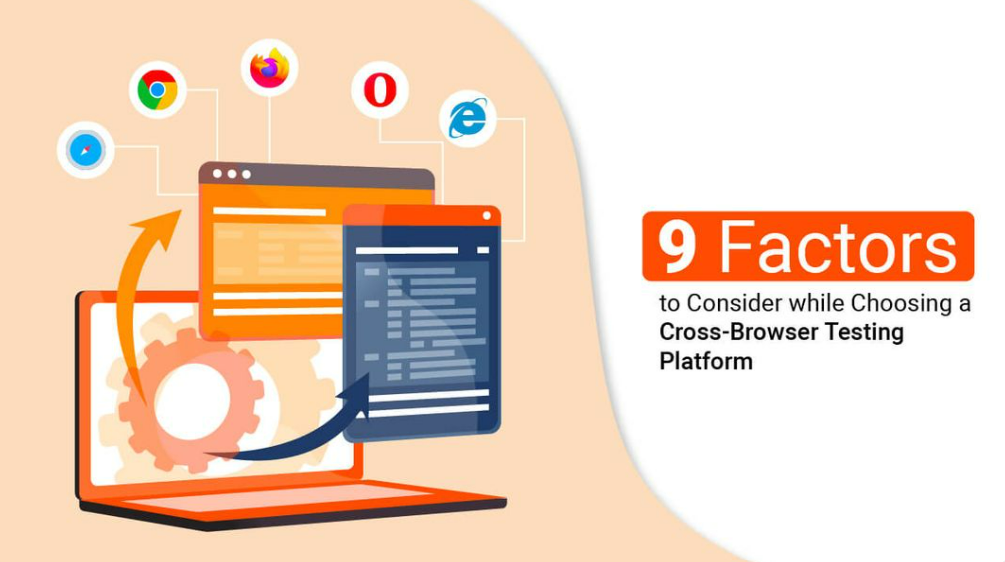9 Facets To Select Cross Platform Testing Tools
 Robert Martin
Robert Martin
Introduction
In the software development industry, the main aim of the cross-platform browser testing process is ensuring a consistent user experience across all browsers and platforms. While web browsers like Google Chrome occupy 63.82% of the global market (as of December 2021), cross-platform testing exists to accommodate the usage of an app on almost all available browsers across the globe. The testers uncover the various fatal troubles that have been hidden during the development process. So, with the assistance of cross-browser testing, the testers can precisely find the location of all of the bugs and get rid of them rapidly. User experience is crucial and enterprises that are not vigilant about device incompatibility risk losing their customers in the competitive market. Testers need a unified platform that meets all the requirements for a successful web application.
Cross browser testing tools play an essential position in ensuring the achievement of the whole development process. Developers need to remember different factors while selecting browser tools. So, in this blog, we discuss all the vital elements that will let you choose the best browser testing tool in step with your business requirements.
Compatibility
While selecting cross browser testing tools, the web application must be checked with all the browsers and working systems. This will ascertain that the application is accessible, responsive, and has a fluid design. Before beginning the testing procedure, thorough research is required on all commonly used browser/ Operating System combinations. An evaluation of the traffic analysis records can assist developers in obtaining a basic idea of all of the popular browsers available currently. For example, developers need to look at the web application on all browsers that receive a minimum of 5% of the overall internet traffic. The development project criteria also have an essential role in deciding on the various combinations.
Test Coverage
All the current web applications consist of complicated features and requirements. Hence, developers need to build large test suites with many test cases to pay attention to specific user interface necessities. A vast portion of the whole development life cycle is taken up by executing these test cases. The developers could easily be oblivious to testing the web application on specific device-specific configurations while focussing on the mentioned test cases. Nowadays, every browser provides a unique combination of features, and lacking any of them may extensively impact the web application's performance. The developers must additionally keep in mind that the maximum of the end-users will now not be using the up-to-date model of any browsers. Hence, they need to supply precedence to older browsers variations.
Integration and Delivery
Continuous delivery and continuous integration are taken into consideration to be the most crucial factors of the cutting-edge development processes. For example, the developers observe agile development practices that need them to conduct test cases frequently. So, it is helpful to pick a browser testing tool that permits them to combine CI/CD and DevOps technology effectively. Moreover, developers need to ensure that the cross-browser testing tool runs parallel test scenarios on various browsers and OS combinations. Features like scriptless test automation and test schedules are some of the features that should be present in the testing tool. These features are exceedingly essential considering the modern web development progress. This ensures a 360° integration with the company's development workflow.
Time Efficiency
Quoting Steve Jobs, "It's evident that the most precious resource we all have is time." In the cut-throat competition of the web development industry, time is one of the determining elements that impact the success of any corporation. So, the developers must select a tool that requires minimal upkeep and manual intervention. It is wise to choose a cross-platform browser testing device that is user-friendly and simple to examine for novices. Features like a quick start guide, accessible components and intuitive navigation make a tool easy for beginners to grasp without any difficulty. In this competitive era, the developer must pick the tools requiring minimal manual intervention to improve and execute test suites. Hence, these features can provide companies with the assistance for extensively reducing the development time and ensuring the speedy supply of efficient web applications to the end-users.
Analytical Tools
Detailed test reports are the best method for fast fixing bugs and efficacy. Besides, the rapid actionable feedback also needs to generate an influential report about all of the failed test cases. All such reports help the developers examine the crucial flaws present in the core framework of the web application being tested. A drill-down method can also be adopted to cautiously discuss all the unsuccessful test cases and report the diagnosed bugs. The cross-browser testing automation platforms like HeadSpin provide beautiful graphics and charts along with test reports and real-time feedback. This additional information allows the developer to stumble on bugs together with the configuration-specific test reports. Moreover, it permits the developers to get a primary idea about the specific part of the web application which has failed to carry out its intended function. They can perform these assessments on any unique browser or operating system.
Automation
Cross-browser testing automation has grown to be one of the most dominant practices of the Web Development Industry currently. Almost all development corporations are remodeling their manual testing environment into a cloud-based automated testing setup in this present era. The developers need to make sure that the cross-browser testing device can gel well with the current automatic testing setup in use. The platforms like HeadSpin assist organizations in carrying out automated cross-browser testing on Appium, Selenium, and Appium Inspector servers. All these features are relatively essential to sustain the quality of the web application. Developers must also pay proper attention to enable DevOps integration of their cross-browser testing setup. The DevOps and Agile integration assist the extraordinary groups of the company to work collectively towards the creation of incredible applications.
Collaboration
The testing team needs to work in close coordination with other teams running at different stages of the development project to bring forth a web application of extremely high quality. This method will allow the testers to report and communicate the ultimate test results with the respective teams, henceforth debugging and removing the issues present. An important position in the whole software testing life cycle is taken up by reporting bugs. Testers should categorize the bugs following their severity and occurrence for a smooth workflow. Time and resources can be optimized in the development life cycle in this manner. For example, the builders would not need replica efforts to find the bugs repeatedly.
Support Team
Customer support must be one of the most vital factors of the developers' checklist while searching for the best cross-platform browser testing tool. Every tool has a unique combination of features and a learning curve. So, the developers should ensure that the learning process is easy for new testers. The device should have a proper way to aid clients with the help of features like phone calls, emails, and live chat. Likewise, it is wise to study the reviews of the cross-browser testing tool. This will assist in recognizing its functions from the point of view.
With the support of an on-premise device laboratory, vast connectivity with real-device testing in 90+ locations around the world, and convenient customer support services, HeadSpin can help the testers get conversant with all the distinct features. In simple terms, the developers should invest in the cross-browser testing platform that supplies its guarantees.
Affordability
The web development industry is commonly known as one of the quickest-growing corporations around the globe. Hence, it is often assumed that new corporations are stepping into this comparative business segment daily. The start-up commercial enterprises cannot afford to make investments worth thousands for a cross-browser testing platform. From an economic point of view, it is essential to find a cross-browser testing tool that can serve the purpose most effectively and be suitable for the budget.
Summary
Cross-platform browser testing performs an essential role in offering web applications of superior quality for end-users. In Q4 of 2021, 54.4% of web traffic around the world was generated through mobile devices. Therefore, a faulty web application can bring forth unsatisfied clients, which can finally result in the agency's downfall. Likewise, this is one of the principal reasons behind hefty monetary transactions but low conversion rates. So, companies need to choose the right cross-browser testing tools to maximize the potential of the development environment to the greatest extent. In this article, various factors were discussed to help businesses choose the best tool in keeping with their respective necessities. Besides, this will be a good measure for the developers who carry out thorough studies based on the latest marketplace trends and patron needs. All these factors will assist the companies in recognizing the needs of their end-users and offering customized services.
Subscribe to my newsletter
Read articles from Robert Martin directly inside your inbox. Subscribe to the newsletter, and don't miss out.
Written by

Robert Martin
Robert Martin
Designing and testing new software programs is what I do for a living and my interest in it has led me to share my knowledge in this platform.